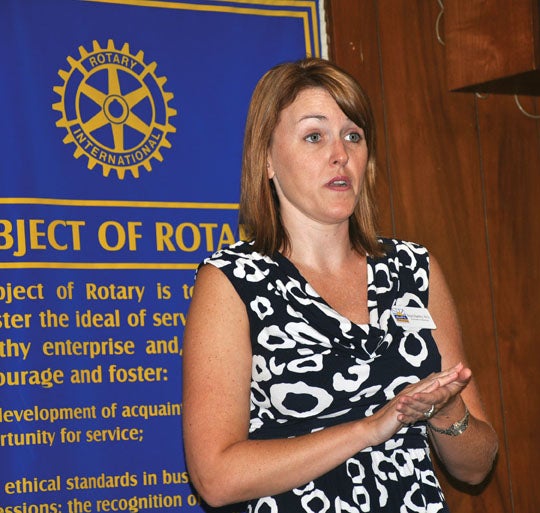Darkness to Light: Working to end child sexual abuse
Published 9:56 pm Thursday, July 19, 2012
Recognizing and preventing child sexual abuse was the topic when Jesse Hartley, executive director of The Children’s Advocacy Center/Hope House in Covington, was the guest speaker at the Bogalusa Rotary Club meeting on Tuesday.
Introducing Hartley was Rev. Bob Adams, a Rotarian, and pastor of First Baptist Church. Adams was instrumental in creating a Children’s Advocacy satellite office in Bogalusa through First Baptist Church to “better serve our Washington Parish clients,” said Hartley.
“We cover all of St. Tammany and Washington Parish.” The services are free at least through 2012, thanks to the sponsorship of Capital One.
Speaking before a group of Rotarians, each of whom has children, grandchildren and/or great-grandchildren, Hartley immediately grabbed the attention of everyone in the room. Her message was sober:
— One in four girls, and one in six boys are sexually abused before they are 18 years old.
— 90 percent of all victims are abused by someone they know.
— There were 247 children interviewed for allegations of abuse at Hope House in 2011.
— Child sexual abuse is a community problem, costing the community $2 million every year.
The primary function of Hope House, said Hartley, is to provide a forensic interview, which is a fact-finding conversation conducted by someone trained in the dynamics of sexual abuse, to determine if a child has been abused. The child may have told a teacher he or she has been abused, and that teacher would be required to report the allegation to Children and Family Services, which would then bring the child to Hope House for a forensic interview.
Hartley said that one very important part of the forensic interview process is the video recording that is produced, with the child’s knowledge, so that he or she will not have to repeat and relive the traumatic experience over and over. The video can be used in court. Not only is the recorded interview an effective and reliable way to present the child’s story to investigators and the court, in many cases it is the only way that a jury will be able to see the child tell the story while still near the age when the abuse occurred. Cases may take a number of years to make their way into a courtroom.
“You have a child who might have been 10 when it (the abuse) happened who is then well into their teens by the time it goes to trial, and it’s hard for a jury to wrap its head around (the fact) this happened to a child when they are seeing maybe an 18-year-old on the stand,” said Hartley.
“The conviction rate is up 85 percent since 1994,” she said. “The majority of our cases we win, and these people are taken off the streets.”
Hartley talked about the Penn State abuse case against Jerry Sandusky, saying, “We see that. Jerry Sandusky is just a textbook perpetrator,” she said. “He was somebody who was respected in the community, he was in a position of authority… He even started a non-profit for abused children.” From the beginning, she said, he was “developing his own pool of victims.” Of the 10 or 12 who have come forward, said Hartley, that’s just a “small, small percentage.”
Of the 247 children counseled at Hope House last year, only five of them did not know their abuser.
“There’s a relationship. These people will establish relationships, not only with the child, but with the family, because in order to gain access to the child, they have to gain the trust of the family, so that the family will then allow them to take their child to football games, etc.”
The Child Advocacy Center and Hope House is working to make the public aware that child abuse absolutely can be prevented.
“Eighty percent of child abuse cases occur when there’s one adult and one child alone together,” Hartley said. “So if you eliminate one adult-one child interaction, you’ve prevented 80 percent of abuse cases.”
Hartley continued, saying that mentoring is still important, but keeping the child and adult in a place where they can be viewed, such as having their sessions outdoors, or in a room that has a window in the door so that anyone passing could see them, is key in those one-on-one interactions.
“Our goal is to train 10,000 adults in St. Tammany and Washington parishes over the next five years,” she said. “We’re proud to report that just in the first year we’ve already trained over 500 adults, and every adult trained can protect up to 10 children from abuse.
“It is our responsibility as adults to protect these children make sure they have a safe community, a safe place to grow up and a safe place to live,” said Hartley.
The Children’s Advocacy Center is part of a network of 700 children’s advocacy centers nation-wide. Any adult interested in becoming trained in how to prevent, recognize and react responsibly to child sexual abuse is encouraged to sign up for the Stewards of Children training program, designed for organizations that serve youth and for individuals concerned about the safety of children.
For further information about the training program or The Children’s Advocacy Center, contact Hartley at 892-3885 or email her at jesse@ sttammanycac.com. The center has a website at www.cachopehouse.org.
Seven steps to protecting our children
• Learn the facts, understand the risks
• Minimize opportunity
• Talk about it with the child
• Stay alert
• Make a plan
• Act on suspicions
• Get involved: Use your voice and your vote to make your community a safer place for our children.


